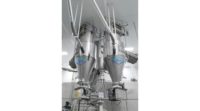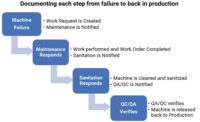Sanitation software helps snack and bakery companies continuously improve

courtesy of AIB International

courtesy of AIB International

courtesy of AIB International



More companies across the food industry have been transitioning to software systems versus paper to manage sanitation scheduling, processes and documentation. This allows them to integrate with sanitation standard operating procedures (SSOPs) and also help improve food safety. They can also help better coordinate regular facility maintenance tasks.
Software vs. paper
“There are several ways to benefit from utilizing custom software programs over paper systems in business today,” says Jeff Dearduff, corporate director, baking and snack, The Austin Company, Chicago. “It starts with having the ability to set up data collection and reporting schemes that prompt you to do something. This drives consistency in data collection and confidence in the reports that are generated.”
Dearduff explains that using software is easier than using paper, especially because you will have a backup of your data. “When you have your operations systems set up properly in a software program or programs, it then leads to a smoother process and more confidence when in an audit and asked to produce documents. Like the paper-based record-keeping processes of the past, you have to back up and protect your data. With electronic record-keeping you have the opportunity to store multiple copies in several locations—unlike paper systems, where a fire or flood event could wipe out history.”
This regulatory aspect cannot be emphasized enough. “Auditors need to see that procedures are being followed and properly documented,” says Jay Wright, vice president, sales, SOMAX, Inc., Atlanta. “With software, key reports and critical information is available with a simple mouse click. Also, the scheduling capabilities of software help ensure that nothing is overlooked or overdue.”
Computerized maintenance management system (CMMS) software is also easier than using paper because there’s no justifiable reason to miss important tasks when parties have direct access to schedules, work requests and work orders, says Daniel Cook, vice president, MaintSmart Software, Inc., North Bend, OR. “With CMMS software, communication is direct and recorded in the software database as history.”
Sanitation software helps keep everyone on task. “The ever-increasing government and private sector standards have drastically increased the need for thorough and consistent documentation, including the actual tasks performed and the ones intended to be performed,” notes Robert Burgh, president, Nexcor Technologies, Atlanta.
New systems
SOMAX has been providing CMMS software to the food processing industry for 30 years, and recently expanded into sanitation and food safety software, says Wright. “Our cloud-based software with mobile apps for Android and iOS allows plants to effectively plan, schedule and document day-to-day activities for both maintenance and sanitation in one fully integrated solution.” All work is recorded and documented in real-time as it is being completed.
The KLEANZ family of products, manufactured by Nexcor Technologies, is constantly being updated to meet the current needs of the food manufacturing industry, says Burgh. “The newest additions to the KLEANZ family are KLEANZ Mobile iOS and KLEANZ Mobile Android. KLEANZ Mobile provides the ability to have a paperless food safety/sanitation operation through real-time tracking and data capture.” It’s also highly configurable and can integrate with maintenance management, process controls, enterprise resource planning (ERP), payroll and other systems.
“KLEANZ is a great tracking system that can automatically change the frequency of certain cleaning tasks based on the condition of equipment or areas,” says Donald Rushing, food safety professional, AIB International, Manhattan, KS. “You can view the cleaning procedures on the floor with an iPad, so that no steps are missed.”
Rushing says that KLEANZ provides a single repository for a facility’s food safety compliance and sanitation management data, in real-time. “This reduces the number of systems needed to manage your quality processes, as well as the associated cost. In addition, errors, omissions and repeat incidents can be eliminated, operations are streamlined, and manual processes are automated, further increasing productivity.”
SSOPs and food safety
“Managing SSOPs and ensuring that procedures are being followed is critical for all food processing plants,” says Wright. “Having a software system in place to manage those SSOPs and the master sanitation schedule is just as important.”
Wright explains that SOMAX’s software is enterprise level, allowing clients to manage SSOPs at a corporate level and then share those procedures with the plant level where any localizations can be applied.
“By integrating with the maintenance management system, SOMAX can show auditors and management the full maintenance history of assets, as well as show that each time maintenance worked on an asset that it was properly cleaned and sanitized before it went back into production,” Wright continues. “SOMAX also offers full verification and validation for QC and QA to sign off and verify that procedures were properly followed.”
Sanitation software can help improve overall food safety, says Rowdy Brixey, president, Brixey Engineering, Inc., Kansas City, MO. “As we all know by now, documentation is critical in the event of a third-party inspection. The latest software helps greatly, but the most-important factor related to food safety is that the work gets performed, and gets performed properly.”
The latest technology allows operators to embed SOPs, drawings, pictures, videos, one point lessons and other job aides that help ensure all sanitation steps are followed and understood, notes Brixey. “In addition, the best software on the market will integrate with maintenance systems to drive an all-inclusive set of job tasks that many times depend on resources from both sanitation and maintenance. This allows work scheduled by either department to trigger resources required within the other.”
Reporting for food safety inspectors could be the difference between passing or failing an inspection, suggests Cook. “When the AIB inspector shows up unexpectedly, producing compliance reports, preventive maintenance and sanitation work histories takes minutes instead of hours. This results in a better general impression and may positively influence the AIB score, resulting in real bottom-line benefits for the entire company.”
Added benefits
“Bakeries and other food manufacturing operations can expect to evaluate the health of their sanitation program with KLEANZ and use the system to further the productivity of the department,” remarks Burgh. He notes KLEANZ provides ROI by focusing on continuous improvement, risk mitigation and preventive self-auditing.
MaintSmart’s CMMS software was originally designed for commercial bakery maintenance and sanitation, says Cook. It can coexist with the sanitation management in the same software system, thereby improving efficiency. “This is possible because of the way this CMMS uses equipment work areas, processes and other groupings, such as task groups. The software user defines these groupings as needed. Examples of task groups could be ‘Bakery Maintenance’ and ‘Bakery Sanitation,’ for example.”
If managed together, says Cook, maintenance would be able to directly access and act upon work requests from sanitation. Likewise, sanitation could see maintenance schedules and other information that affects how maintenance and sanitation work together—or around each other. “This promotes communication and harmony between these two departments, which traditionally are at odds with one another.”
Software can also help track trends for snack and bakery companies, specifically those related to frequent sanitation tracks.
“For instance, if your schedule calls for 60 minutes of cleaning every day and it takes only 15 minutes and really needs to be done every other day, the software will let you know that,” explains Rushing. “It helps your bakery operation become more efficient by identifying the need to adjust time and manpower to what is truly needed.”
Looking for a reprint of this article?
From high-res PDFs to custom plaques, order your copy today!









